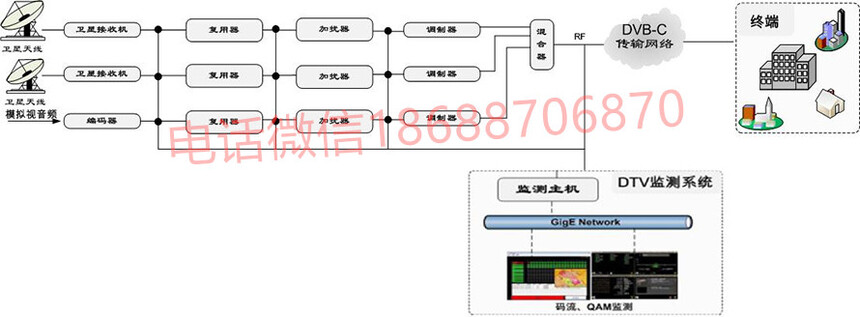1. Design Principles
· Achieve comprehensive monitoring across all regions, multiple stages, and diverse functions in digital TV broadcasting.
· Enable quality monitoring, content monitoring, security monitoring, and service monitoring for digital TV broadcasts.
· Implement monitoring for centralized digital TV systems based on TS over IP switching and transmission technologies.
· Establish a hybrid monitoring model combining real-time monitoring of critical program signals with periodic monitoring of other program signals.

2. System Monitoring Stages
Source Signal Monitoring:
As the source of digital TV signals, the quality and characteristics of the source directly determine the system’s overall quality and security. Real-time online monitoring is essential for satellite reception signals and encoder signals. Multi-screen real-time viewing and transcoding/storage are applied to satellite-received programs and encoder outputs.
Bitstream Core Processing Monitoring:
Focuses on MPEG/TS core processing. Real-time bitstream content analysis ensures continuous monitoring of image quality after core processing.
QAM Modulation Output Monitoring:
As the final stage of the digital TV headend system, signal quality at this stage directly impacts user viewing experiences. Real-time monitoring of broadcast bitstream content is implemented.
3. Monitoring System Architecture
For most modern digital TV headend platforms, this solution prioritizes monitoring at the QAM Modulation Output stage. If feasible, multi-layered, multi-screen monitoring can be extended to source signals (satellite reception/encoding) and bitstream multiplexing points.
Professional monitoring equipment analyzes processed bitstreams. Uniform processing is applied to different signal types, converting device alarms into SNMP protocols while transforming monitored bitstreams into TS over IP signals. The system also supports demodulation of modulated signals.
Using the DMM-1900P, ASI and QAM signals can be converted into IP signals for bitstream monitoring and program viewing.
4. Monitoring System Functions
① Embedded LINUX Operating System: Ensures system security and stability.
② Bitstream-Level Quality Monitoring: Detects issues such as frozen frames, black frames, audio loss, and mono audio.
③ Stream Polling Monitoring: Supports cyclic monitoring of bitstreams.
④ Alarm Strategy Configuration: Alarms can be configured based on occurrence frequency.
⑤ Multi-Layer Polling Monitoring: Supports RF signal polling, ASI interface signal polling, and IP multicast stream polling.
⑥ Service-, PID-, Time-, and Tolerance-Based Alarm Policies: Customizable strategies for alarms, including service/PID association, time windows, and tolerance thresholds.
⑦ Local Alarm Storage: Stores alarm data locally for 12 months, with query capabilities by time, type, and severity.
⑧ Measurement Log Storage: Records bandwidth, PCR values, packet jitter, etc., at 1-second intervals for 2 months. Data can be exported as graphs or Excel files.
⑨ Custom Monitoring Plans: Users can define and schedule different monitoring strategies for specific time periods.
⑩ Custom Alarm Policies: Configure tolerance time, PID filtering, alarm severity, and thresholds for alarm frequency.
⑪ Alarm Recovery Notifications: Alerts users when alarms are resolved.
⑫ Multi-Channel Alarm Delivery: Supports GUI alerts, pop-up windows, SNMP traps, audible alarms, relays, COM port triggers, stream capture, and remote/local window pop-ups.
⑬ Real-Time Transcoding & Forwarding: Streams monitored content via TS over IP for remote viewing/listening.
⑭ Remote Access Protocols:
· VNC: Free remote desktop client for configuration, deep stream analysis, and system maintenance.
· HTML/IE Access: Enables data queries, stream downloads, system upgrades, remote recording, offline analysis, and I-frame-based program backhaul (minimum 56 Kbps bandwidth).
⑮ NTP Network Clock Synchronization: Ensures time accuracy across the system.
⑯ Open Protocol Support: Allows secondary development via exposed underlying protocols.
⑰ Stream Forwarding & Filtering: Supports TS over IP forwarding with PID-based program filtering.
数字电视播出监测系统是针对数字电视系统进行的实时码流监测,是保证数字电视系统稳定运行和传媒系统的播出安全的关键,为数字电视运营商提供一个安全可靠、集成化、统一完整的数字广播电视信号自动监测平台。
1、设计理念
实现数字电视播出中的全区域、多环节、多功能的完整监测;
实现数字电视播出中的质量监测、内容监测、安全监测和服务监测;
实现基于对TS over IP交换和传输技术的集中式数字电视系统的监测;
建立对重点节目播出信号实时监测和其它节目播出信号周期性监测相结合的模式。
2、系统监测环节
信源监测:作为数字电视源端,信号的质量和性质直接决定了整个数字电视系统的质量和安全性,对其的监测至关重要。对卫星接收信号、编码器信号进行实时在线监测,对卫星接收节目、编码器通过多画面实时监看和转码存储。
码流核心处理监测:对MPEG/TS核心处理的监测,采用码流内容的实时监测方式,对码流核心处理后输出的图像质量实时监测。
QAM调制输出监测:作为数字电视前端系统的末级,信号的质量直接影响到用户的收看效果,对播出码流的内容实时的监测。
3、监测系统架构
针对当今大部分数字电视前端播出平台的架构,本方案建议对前端系统的监测主要在QAM调制输出监测点。条件允许可以对信源(卫星接收/编码)监测、码流复用监测等监测点进行多层次、多画面的监测。
通过专业的监测设备对处理后的码流信号进行码流检测分析。对不同种类的被监测信号进行统一的处理,在这个层面设备的报警信号转化成SNMP的协议,同时将被监测的码流信号处理成TS over IP的信号,同时可以对调制后的信号进行解调。可以通过PACIFIC-9900P将ASI、QAM的信号处理为IP的信号进行码流监测、节目的监视。
4、监测系统功能
① 采用嵌入式LINUX操作系统,系统安全、稳定;
② 在码流层面可以对节目的质量进行监测,静帧、黑场、音频丢失、单音;
③ 支持码流的轮询监测功能;
④ 所有报警可以根据报警的发生次数制定报警的策略;
⑤ 支持RF信号的轮询监测功能,支持ASI接口信号轮询监测的功能,支持IP码流组播轮询的监测功能;
⑥ 基于服务、PID的报警策略、时间策略、容忍度策略;
⑦ 系统支持报警数据本地存储,提供12个月的本地报警存储的功能,可以根据报警时间、报警类型、报警级别等进行报警数据的查询;
⑧ 系统本身支持测量日志的存储,用户可以对播出码流的每个带宽、PCR数值、包间隔抖动数值进行定时的采集(精度1秒),采集的数据可以通过图像曲线发布、或者转换成EXCEL的表格,提供2个月的数据采集本地存储;
⑨ 用户可以定制监测计划,并可以在不同的时间调入不同的策略对信号进行监测;
⑩ 用户自定报警策略,根据用户的需求通过设定报警容忍时间、过滤PID、设定报警级别、单位时间报警个数门限等安排报警策略;
⑪ 提供报警恢复的提示功能;
⑫ 系统可以配置报警方式,包括:GUI的显示报警、GUI中窗口弹出报警、SNMP网络报警发布、声音、继电器、COM端口、触发码流捕捉、本地异地窗口弹出等功能;
⑬ 系统支持实时码流转码的功能,用户可以将被监测的码流、码流中的节目通过TS OVER IP的方式进行转发,使用户可以远程监看、监听;
⑭ 支持VNC、HTML访问的方式:VNC为远程桌面客户端软件(免费),实现对异地监测界面的访问,实现系统的配置、码流的深度分析;IE方式的访问主要提供数据的查询、码流的下载、系统的维护、远程软件升级服务、远程录制码流下载服务、运程码流离线分析功能。同时远端平台ES层节目的内容可以通过I帧的方式回传到本地,最低带宽为56K。
⑮ 提供NTP网络时钟同步;
⑯ 底层协议开放,支持用户的二次开发;
⑰ 被监测的码流支持转发的功能,通过TS OVER IP的方式进行转发,并可以支持PID节目过滤的功能。







